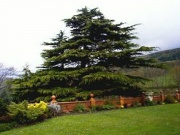Difference between revisions of "Cedar of Lebanon"
(username removed) |
(username removed) |
||
| Line 6: | Line 6: | ||
== Synonyms and Related Terms == | == Synonyms and Related Terms == | ||
| − | ''Cedrus libani''; | + | ''Cedrus libani''; cèdre du Liban (Fr.); Libanon-Zedar (Deut.); cedro del Libano (Esp., It.); cedro do Libano (Port.) |
== Other Properties == | == Other Properties == | ||
| Line 27: | Line 27: | ||
== Authority == | == Authority == | ||
| − | * ''Encyclopedia Britannica'', http://www.britannica.com Comment: "cedar" | + | * ''Encyclopedia Britannica'', http://www.britannica.com Comment: "cedar" Encyclopædia Britannica from Encyclopædia Britannica Premium Service. [Accessed May 5, 2004]. |
* ''Ancient Egyptian Materials and Technologies'', Paul Nicholson, Ian Shaw (eds.), Cambridge University Press, Cambridge, 2000 Comment: R.Gale, P.Gasson, N.Hepper, G.Killen, "Wood" | * ''Ancient Egyptian Materials and Technologies'', Paul Nicholson, Ian Shaw (eds.), Cambridge University Press, Cambridge, 2000 Comment: R.Gale, P.Gasson, N.Hepper, G.Killen, "Wood" | ||
| − | * | + | * H.L.Edlin, ''What Wood is That?'', Viking Press, New York, 1969 |
[[Category:Materials database]] | [[Category:Materials database]] | ||
Revision as of 07:40, 24 July 2013
Description
A large conical shaped evergreen, Cedrus libani, native to Asia Minor. Cedar of Lebanon is one of the few true cedar trees although many other aromatic evergreens are commonly called cedars. Cedars are characterized by having an strong smelling volatile oil whose odor persists after the wood is cut and dried. The soft, lightweight wood has a fine grain, two alternating colors and takes a beautiful polish. Cedar is durable and very resistant to insects and rotting. In ancient Egypt, cedar was used for sarcophagi, coffins, statuary and burial shrines (Gale et al 2000). Currently cedar is used for construction, cabinetry, interior trim, closets and chest. Other true cedar trees are Atlas cedar (C. atlantica), Cyprus cedar (C. brevifolia), and deodar (C. deodara).
Synonyms and Related Terms
Cedrus libani; cèdre du Liban (Fr.); Libanon-Zedar (Deut.); cedro del Libano (Esp., It.); cedro do Libano (Port.)
Other Properties
Color: Alternating regions of reddish brown and light brown. High resin content, resin canals visible. Aromatic. Rings: distinct. Pores: absent. Grain: distinct. Rays: obscure. Soft, lightweight.
| Density | 28 ppcf |
|---|---|
| Molecular Weight | specific gravity = 0.45 |
Additional Information
R.Gale, P.Gasson, N.Hepper, G.Killen, "Wood" in Ancient Egyptian Materials and Technology, P.Nicholson, I.Shaw (eds.), Cambridge University Press, 2000, p. 334-371.
Authority
- Encyclopedia Britannica, http://www.britannica.com Comment: "cedar" Encyclopædia Britannica from Encyclopædia Britannica Premium Service. [Accessed May 5, 2004].
- Ancient Egyptian Materials and Technologies, Paul Nicholson, Ian Shaw (eds.), Cambridge University Press, Cambridge, 2000 Comment: R.Gale, P.Gasson, N.Hepper, G.Killen, "Wood"
- H.L.Edlin, What Wood is That?, Viking Press, New York, 1969
